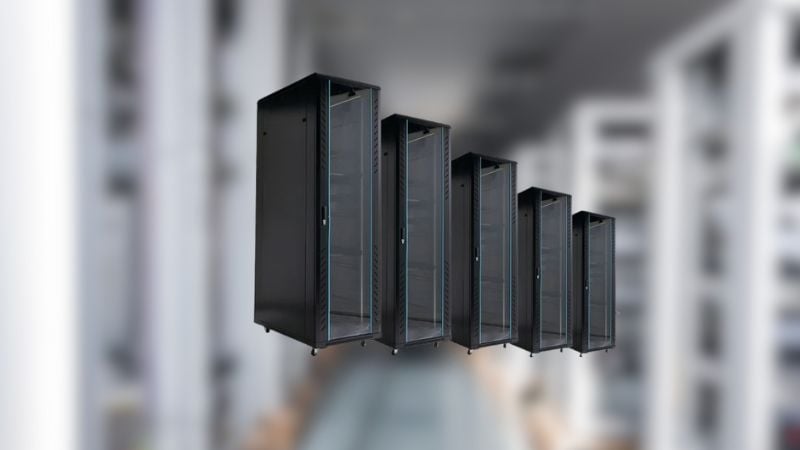Blog, Network Cabling
Understanding Data Center Server Rack Size: A Beginner’s Guide
The right server rack size is essential for the efficient operation and management of a data center. However, the optimal size of the Rack is tough to choose. This guide will give you an overview of various server rack dimensions, how to select an appropriate rack size and potential future trends. You can make an informed selection for your data center on these aspects.
Table of contents
What is a Data Center Server Rack
A server rack is a standard frame for deploying data servers and network devices. It makes data center equipment organized, secure, and manageable. Server racks are essential in data centers, and they are made up of three types: open racks, enclosed racks, and cabinets.
There are two relative standards, EIA-310 and IEC 60297. They specify the standard dimension of the 19-inch Rack and the layout of the mounting hole. There is an organization, Open Compute Project (OCP), dedicated to data center hardware standardization and innovation. It has developed design standards for open Rack.
Server Rack Width
There are three primary dimensions of the data center server rack size. The first is rack width. We often hear of a 19-inch rack, and this ’19-inch’ refers to the standard width of the Rack. Most server racks we use are 19-inch because the rack-mountable server equipment we use also almost always has 19-inch mounting panels. (Actually, less than 19 inches).

So, 19-inch can be considered universal and stable, and we rarely worry about racks being the wrong width. You need to know that 19-inch refers to the internal width of the Rack, and its external width is typically 24 inches. This matches the 24×24-inch size of raised floors in data centers.
Server Rack Height
To understand the height of a server rack, first, we need to know the concept of Rack Unit, abbreviation U, or RU. The rack unit is the standard unit used to measure rack height. 1U equals 1.75 inches (44.45mm).
For the data center, according to the Data Center Rack Market 2025-2033, typically used rack heights include 36U, 42U, 45U, 47U, 48U, 51U, and others. Among them, the two most common heights are 42U and 48U. The 42U rack height is 73.5 inches, about 6 ft. The 48U rack height is 84 inches, equal to 7 ft. So they are also called 6-foot Rack and 7-foot Rack. Racks of these two heights are tall enough to accommodate equipment and are easy to manage and maintain.

Some people refer to 42U as the standard height rack, but there is no true “standard” height for racks; 42U is just the most popular. We also use RU/U to represent the height of devices installed in a rack, such as servers, switches, power units, etc. These are typically between 1U and 4U. The total U of the devices must be less than the Rack.
Server Rack Depth
The server rack depth, meaning the distance from the front to the back of the Rack, directly affects the server size. Theoretically, the depth of a rack can range from 1 to 50 inches. Common depths are 24 inches and 42 inches. Additionally, 29 inches is quite common for open racks, and brands like Dell, HP, and IBM often use this depth. Racks with greater depth can mount smaller devices using rack rail.
Others
Half Rack
There is no formal standard for half racks. However, it is generally divided into two types: half-width and half-height. A half-width rack has a width that is half a 19-inch rack(9.5 inches). A half-height rack typically has a height of 22U or 27U.
2-Post Rack and 4-Post Rack
These two types exist in open racks. A 2-post rack has two vertical support columns, while a 4-post rack has four. Their different structures determine the inherent depth differences. 2-post racks have a shallower depth and can support lighter equipment such as switches and patch panels. 4-post racks have a deeper depth and a more stable structure. They can support heavy equipment. In addition, some 2-post racks can be converted into 4-post racks using a caster kit.

Considerations when Choosing Server Rack Size
Rack Height
The taller the server rack, the more equipment can be accommodated when the footprint is fixed and the server room height permits. Shorter racks may be easier to manage and maintain. There is no right or wrong option, depending on whether it can accommodate the necessary equipment and be cost-effective.
One thing to remember is to estimate redundancy and the space you may need in the future to facilitate your expansion needs. For example, if a 42U rack is sufficient, consider a 45U or 48U rack.
Power and Cable Management
The need for a power distribution unit(PDU) and cables directly impact the data center server rack’s depth. If more cables and PDU are required, deeper racks are needed.
Cooling and Airflow
Proper cooling is essential for data center operations. When choosing a server rack size, ensure that the equipment is not overcrowded and that there is enough space to ensure adequate airflow. Larger sizes need to be considered if additional cooling accessories are available.
Server Room Layout
The data center server rack size affects the organization and efficiency of your server room layout; choose the proper rack depth and width to avoid oversizing.
Potential Trends to Rack Size
Edge Computing
Edge computing brings data processing closer to the source and changes the traditional data center layout. Data centers with edge computing are smaller and more distributed than traditional central data centers. More compact, small form factor racks may be required.
High Density Rack
Data traffic and storage are growing rapidly, and data centers are expanding their data capacity, requiring more efficient equipment stacking and cooling. High-density racks are increasingly in demand.
Energy-efficient Rack Designs
Energy efficiency and sustainability are current concerns in the data center industry, and this is where data center racks are headed. Some racks are beginning to incorporate energy-efficient designs, such as integrated cooling systems and PDUs. This allows users to focus more on equipment needs when choosing rack sizes.
AI in Data Center
The rapid development of AI has significantly impacted the data center industry. First, introducing AI into data centers has brought about many technical optimizations, such as using AI for intelligent allocation and management of rack space, which may require larger rack sizes.
Second is the rise of AI data centers. AI data centers have huge arithmetic requirements, including more powerful power supply and cooling systems, which may require rack improvements to optimize the design. Larger graphics processing unit (GPU) clusters require more or taller racks.
Conclusion
Choosing the right server rack for your data center is key to improving power protection, cooling, cable management, and security. Considering all the factors discussed in this article and carefully considering your needs, you can select the best server rack or cabinet for your setup.
Read More:
- What is Data Center Cabling? A Basic Guide
- Blade server vs Rack server, which one should you choose?
Reference:







